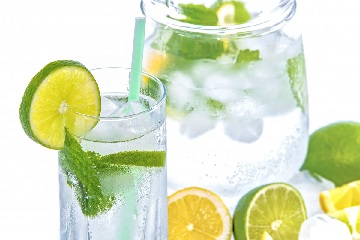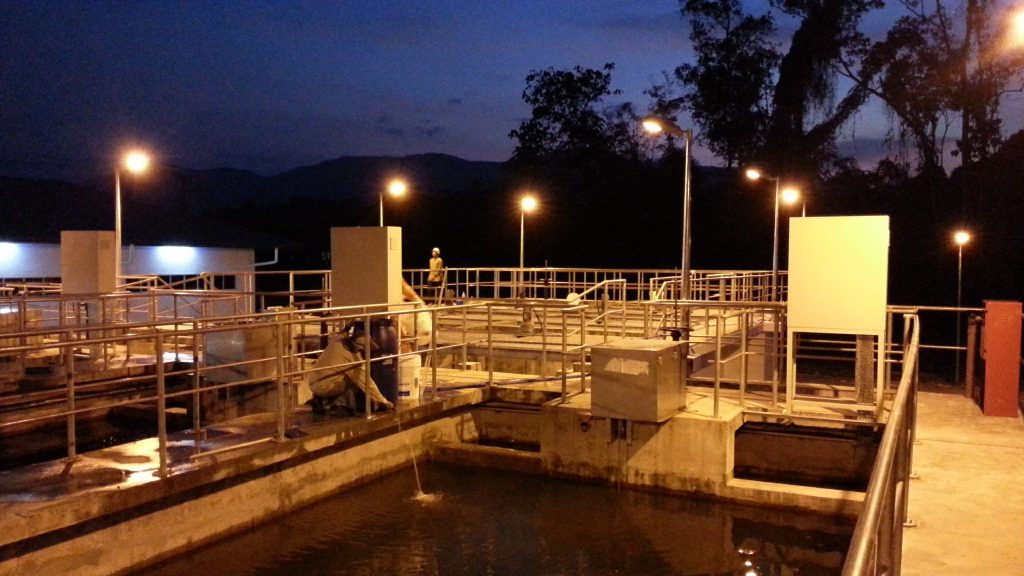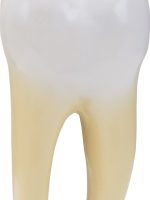Water - 2/3 of you! - For health you need to keep hydrated

The body's water content is 60 - 70% of its total volume
99% of molecules in your body are water molecules! (calculated by Gerald Pollack, PhD, Professor of Bioengineering at University.of Washington)
Distribution of water in the body
2/3 of the body’s water is contained inside the cells.
1/3 is outside the cell
- 2/3 of this extracellular water is in the space between the cells (interstitial space)
- 1/3 is inside the blood vessels. When the body loses water it is usually from the bloodstream.
How much water should we drink and when?
A moderate intake of water is 4 - 8 oz. glasses / day
Common sense says to AVOID dehydration – a condition serious enough that your body will immediately sound the alarm by making you feel thirsty. Sufficient water intake is required to deliver oxygen via the bloodstream to the body’s cells, especially to the brain. Dehydration causes your urine to become darker and stronger smelling and bowel movements to be harder and more difficult to pass. Although, water is used for flushing toxins from the body, you don’t want to “water down” to the point that good nutrients are also washed out of the body.
Obviously drink more when your body is losing more water. E.g.in hot weather, after exercise.
Steady absorption of water keeps your body better hydrated:
- Sip water throughout the day. If you gulp it down, more water is excreted in urine.
- Consume sufficient fiber (flaxseed is excellent) helps retain water in the intestines to be absorbed slowly and keep you hydrated longer.
For fast absorption (after becoming dehydrated):
- Drink water on an empty stomach. Enables water to pass quickly from stomach to intestine to bloodstream in as little as 5 minutes, compared to 45 mins to 2 hours when taken with a meal.
- Water temperature is best between 45 and 55ºF. This temperature seems to help speed up the water’s journey and absorption.
Getting enough sleep increases hydration. According to a Harvard study, published in 2018, getting less than 6 hours sleep a night increases your chances of being dehydrated in the morning by 59%, and may be the reason you feel tired, not “on the ball” and have a headache when you wake up.
Drinking too much water with a meal will dilute the hydrochloric acid in your stomach affecting its protein-digesting ability. It is probably unwise to drink too much water at any time, so spread it throughout the day. You don’t want to drink so much that you need to constantly run to the bathroom or develop a dislike for it.
Drink a glass of water first thing upon waking. Your body has been busy working all night restoring your body and will thank you. This will also help get rid of that morning breath.
Add a pinch of salt to your water to promote hydration of your cells.
TIPS to persuade you to drink more water:
- Add something zingy to your water to make it more palatable and enticing. E.g. a slice of lime or lemon, a dash of lime or lemon juice (Limes/lemons provide antioxidants and break down to alkalizing minerals in the body). A splash of raw apple cider vinegar adds multiple health benefits.
- Keep a water supply on hand at all times.
Drinking water is best in its natural state
Unfortunately, availability of good drinking water is fast becoming a global concern
Good, natural water is a liquid crystal containing an overall negative charge
Individual water molecules create varying degrees of orderly structure with one another.
When highly structured, the water can hold information and has energy. Structured water usually has a negative charge. i.e. potential energy, due to an excess of electrons.
Water in a deep well is charged by the Earth’s geomagnetic field.
Water naturally drawn from a well in a bucket or other container retains its energetic electrons.
Piped delivery de-structures water. Forcing water through pipes causes it to contain fewer electrons, and therefore less energy for the body to utilize.
Sea water, waterfalls, bubbling streams contain energy introduced by their constant movement.
What are your drinking water choices?
Good water smells and tastes good!
Best choices
Preferably obtained from a natural, earth-energized, unpolluted spring or deep well. When bottled, these sources are usually detoxified by ozonation (not harmful to the body) to remove bacteria, etc.
- Natural spring water. Collected at the source or via a bore that taps the underground formation.
- Well water
- Mineral water (naturally high in minerals).
Poor choices
- Purified Water. Don’t be fooled by labels depicting majestic mountains or shimmering bodies of water. Flat-tasting, purified water is drawn from the municipally treated water system! This treated water is then purified by any of reverse osmosis, de-ionization and /or micro filtration. Purifying water by these methods removes beneficial minerals and trace minerals (although some brands (E.g. Dasani, add a few minerals back in for taste).
Purified water brands include Aquafina®(Pepsi®); Dasani®(Coco-Cola®); Dannon®(Group Danone); Poland Spring® (Nestle®).
- Distilled Water. Is devoid of energy and leaches minerals from the body.
- Chemically- treated water. Water should obviously not be microbially contaminated, but over-treating it with detrimental chemicals is also shown to have detrimental effects on health:
Fluoride is added to more than half the U.S. drinking water supply and the rationale for fluoridating the water supply is based on fraudulent and dishonestly presented research.
Fluoride – “Mega Health Fraud”
Chlorine (in excessive amounts) is having deleterious consequences on our health.
Chlorination – “Disease-causing disinfectant in your water”
There are healthier methods available to disinfect water.
Bottled Water
U.S. FDA "Standards of Identity" for Bottled Water
The FDA has established “Standards of Identity” for bottled water products sold in the U.S.. These are some of the more common U.S. types of bottled water:
- Mineral Water – contains at least 250 parts per million total dissolved solids (TDS). It comes from a source tapped at one or more bore holes or spring, and originates from a geologically and physically protected underground water source. No minerals may be added to this water.
- Spring Water – comes from an underground formation from which water flows naturally to the Earth’s surface.
- Well Water – taken from a well;
- Purified water – produced by distillation, deionization, reverse osmosis, or other suitable processes. Purified water may also be referred to as “demineralized water.” It meets the definition of “purified water” in the United States Pharmacopoeia.
- Artesian Water – originates from a confined aquifer that has been tapped and in which the water level stands at some height above the top of the aquifer.
- Fluoridated Water – contains fluoride added within the limitations established in the FDA Code of Federal Regulations. This category includes water classified as “For Infants” or “Nursery.”
- Ground Water – from an underground source that is under a pressure equal to or greater than atmospheric pressure.
- Sparkling Water – contains the same amount of carbon dioxide that it had at emergence from the source. The carbon dioxide may be removed and replenished after treatment.
- Sterile Water – meets the requirements under “sterility tests” in the U.S. Pharmacopoeia.
Energy-enhanced water
Emerging technologies are being used to energize / structure water
Hopefully, these methods will eventually replace our current chemical water treatment methods. It is important to recognize that all electromagnetically charged water, natural or otherwise, loses its charge after about 4 days.
• Electromagnetic fields based on the frequencies of the human bio-fields
- Homeopathic remedies, Bach flower essences. Natural EMFs from electron-rich plant parts are introduced into water under the influence of solar energy;
- Infrared radiation
- Light
- Cooling down water. Cooling to about 39 °F has been shown to energize and structure water;
- Spiraling Water. Spiraling water imparts a healthful effect on water. Austrian, Victor Schauberger, referred to as the father of implosion technology, spent much of his life studying the movement of natural waters, and found that nature self-cleanses and imparts energy to water by creating a vortex in the water. This principal has been harnessed in the form of mechanisms that cause water to spiral and form a vortex. Even the simple action of stirring water with a spoon helps structure water.
For more information on structuring water: see Dr. Mercola interview with Dr. Pollack
Beneficial health effects of water
Younger looking skin
Water flushes out impurities in your skin. Leaving you with a clear, glowing complexion. Skin that is becoming saggy, either due to aging or weight loss, plumps up very nicely when the skin cells are hydrated;
Weight loss
Drinking sufficient water will help lose the pounds. A main job of the liver is to convert stored fat to energy — another is to “sub” for the kidneys if they are water-deprived. Having to do the kidneys’ job as well as its own reduces the liver’s productivity of converting your fat to energy. Drinking extra water, you will quickly notice a decrease in appetite (since the body is better “burning” your fat for fuel and the stomach feels fuller);
Muscle contraction
Muscles that have all the water they need contract more easily;
Normalize high blood pressure
Dehydration is a main driver of high blood pressure. This requires the human body to use a lower blood volume. This in turn requires the artery wall muscles to contract so that the arteries have a narrower cross section. The narrower artery cross sections require the heart to pump harder and faster to get an adequate blood flow supply to all body organs and tissue.
Shower / Bathing water
Add a filter to shower head etc
Chlorinated shower and bathing water should at least be filtered to prevent entry of toxins released by the hot water. E.g. chlorine, chloroform absorbed through the skin and from breathing them, even more damaging. A filter with KDF medium can easily be installed at the shower head. (carbon filters do not remove chlorine compounds, called organochlorines). Showering with residential, chlorinated water is suspected of causing elevated levels of chloroform in the home – up to 100 times higher during a ten-minute shower.
“In a lifetime, approximately 50 pounds of toxic wastes can enter the body from drinking water and at least 450 pounds can enter the body through skin absorption. Little attention has been paid to skin absorption as a route of entry for volatile organic chemicals.”
– Wellness Lifestyle January 1990
Bottled water
Contaminants in bottled water
2020 Consumer Reports article reports toxic PFAs found in several brands of bottled water;
2008 independent test performed by the Environmental Working Group (EWG) revealed 38 low-level contaminants in bottled water. Each of 10 tested brands containing an average of eight chemicals including disinfection byproducts (DBPs), caffeine, Tylenol, nitrate, industrial chemicals, arsenic, and bacteria;
Once opened, bacteria accumulates quickly in plastic bottles. Drink the entire bottle within a day or two.
Contaminants from plastic in bottles leach into water As bottled water sits around, chemicals leach from the bottle plastic into the water
- Antimony. This potentially toxic trace element, was found in PET (#1) bottled water in concentrations reaching >100 times the average level of antimony in unpolluted ground waters. Antimony trioxide is used as a catalyst in the manufacture of PET (labeled #1 for recycling). Antimony levels in 15 Canadian and 48 European brands were measured. When bottles were left to sit at room temperature for 6 months, antimony concentrations increased 19% in Canadian and 90% in European bottled waters. [Shotyk et al, 2007]
- Warmer and colder temperatures increase leach rate of chemicals into the water
– Do not drink water from plastic bottles left in the car in warm temperature
– Do not freeze water in plastic bottles
- 5 gallon clear (#7 hard plastic) polyethylene containers (typically used in water dispensers) contain harmful endocrine disruptor BPA. Shown to mimic estrogen and so cause health concerns by contributing to estrogen dominance condition.
Xenoestrogens – “Gender Benders”
Safe plastics – not known to leach harmful substances:
- Polypropylene – #5 PP
- High-density polyethylene – #2 HDPE
- Low-density polyethylene – #4 LDPE
Check expiration dates. Usually ~18 months from bottling.
The exponentially growing bottled water industry adds a significant cost to the environment
Major food/drink supply companies are cashing in on man’s basic need for unpolluted water. The price of a liter of bottled water is currently more than a liter of gasoline and spending for bottled water averages $400/person in the U.S. – in 40% of cases the bottled water is simply treated tap water.
Energy consumption. A large amount of energy is consumed in processing the water, plastic bottle manufacture and transportation.
Plastic bottles are mounting up in landfills, roads and waters worldwide
- 1,500 water bottles are thrown away every second!
- Plastic pollution is a serious problem killing 1 million seabirds, 100,000 marine mammals, and many fish in just the N. Pacific every year – Researchers testing the ocean water shockingly found it contained 6 times more weight of miniscule plastic pieces as plankton.
References
Shotyk W, et al, Contamination of Bottled Waters with Antimony Leaching from PET. Increases upon Storage, Environ. Sci. Technol. 2007















